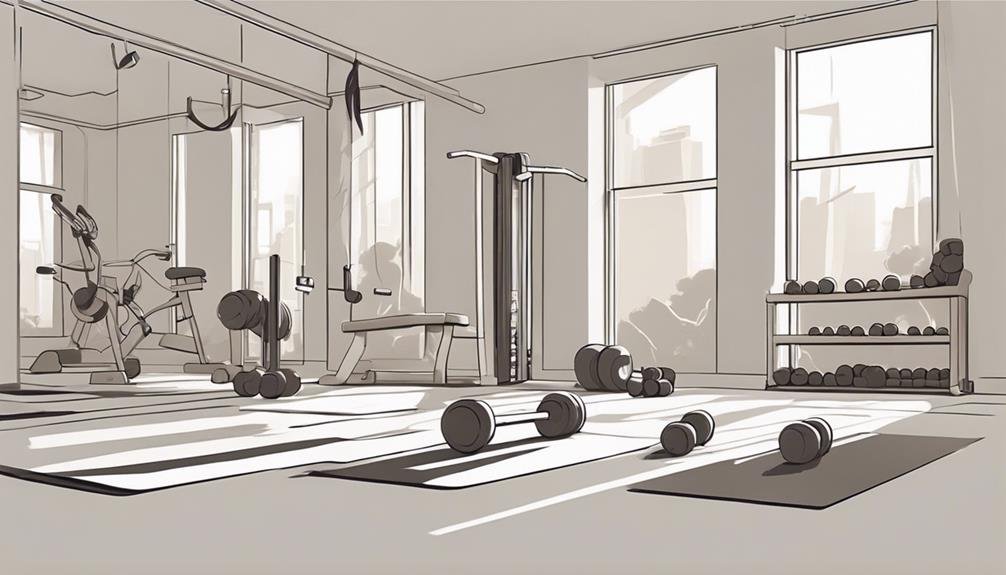5 Effective Muscle-Building Tips for Men Over 40
To effectively build muscle after 40, start by prioritizing strength training at least 2-3 times a week, focusing on major muscle groups. Incorporate compound exercises like squats and bench presses for maximum efficiency. Next, optimize your nutrition with a balanced diet rich in lean proteins and healthy fats, ensuring you hydrate well. Don't forget to include flexibility workouts to enhance mobility and reduce injury risk. Most importantly, track your progress regularly to stay motivated and make necessary adjustments. Keep these tips in mind, and you're on your way to achieving your muscle-building goals with plenty more insights to explore!
Key Takeaways
- Prioritize strength training by engaging in 2-3 sessions per week, focusing on all major muscle groups for optimal muscle growth.
- Incorporate compound exercises like squats and deadlifts to efficiently work multiple muscle groups and enhance functional fitness.
- Optimize nutrition with a balanced diet rich in lean proteins, healthy fats, and complex carbohydrates, aiming for adequate protein intake.
- Include flexibility workouts 2-3 times weekly, utilizing dynamic stretches before and static stretches after workouts to improve mobility.
Prioritize Strength Training
To build muscle effectively after 40, you should prioritize strength training in your fitness routine. Strength training not only helps increase muscle mass but also boosts metabolism, which tends to slow down with age.
Aim for at least two to three sessions per week, focusing on all major muscle groups. You don't have to lift heavy weights; using resistance bands or bodyweight exercises can be just as effective.
Make sure to allow adequate recovery time between sessions, as your muscles need it to repair and grow. Consistency is key, so create a schedule that fits your lifestyle.
Focus on Compound Exercises

Incorporating compound exercises into your strength training routine can greatly enhance muscle growth and overall fitness.
These exercises engage multiple muscle groups simultaneously, making them efficient and effective.
Movements like squats, deadlifts, bench presses, and pull-ups not only build strength but also improve functional fitness, which is vital as you age.
Optimize Nutrition and Recovery
Optimizing your nutrition and recovery is essential for building muscle and maintaining overall health as you age.
Focus on a balanced diet rich in lean proteins, healthy fats, and complex carbohydrates. Aim for at least 1.2 to 2.0 grams of protein per kilogram of body weight to support muscle repair and growth.
Don't forget to hydrate; water plays a significant role in recovery.
Prioritize sleep, aiming for 7-9 hours per night, as it's when your body repairs itself.
Incorporate rest days into your routine to prevent overtraining and allow muscles to recover fully.
Finally, consider meal timing; consuming protein-rich snacks post-workout can enhance recovery.
Incorporate Flexibility Workouts

Flexibility workouts play an essential role in complementing your nutrition and recovery efforts by enhancing mobility and reducing the risk of injury as you build muscle.
Incorporating stretching and mobility exercises into your routine helps maintain joint health and improves overall performance. Aim to include flexibility training at least two to three times a week, focusing on major muscle groups.
Dynamic stretches before workouts can warm up your muscles, while static stretches afterward help with recovery.
Activities like yoga or Pilates not only enhance flexibility but also promote mindfulness, which can keep you motivated.
Track Progress Consistently
Tracking your progress consistently is essential for ensuring you're on the right path to achieving your muscle-building goals. By regularly monitoring your workouts and results, you can identify what works and what doesn't, making it easier to adjust your routine as needed. Use a journal or app to log your exercises, weights, and reps. Remember to also track your body measurements and how you feel physically and mentally.
- Set specific, measurable goals.
- Record your workouts after each session.
- Take progress photos every month.
Staying accountable helps you stay motivated, and seeing how far you've come can fuel your dedication to building muscle effectively.
Questions
Can I Build Muscle Without a Gym Membership?
Yes, you can build muscle without a gym membership! Utilize bodyweight exercises, resistance bands, or free weights at home. Stay consistent, challenge yourself, and focus on proper nutrition to achieve your muscle-building goals effectively.
What Supplements Are Safe for Men Over 40?
When considering supplements, you should focus on vitamin D, omega-3 fatty acids, and protein powders. These can support your health and help with muscle maintenance. Always consult a healthcare professional before starting any new supplement.
How Important Is Sleep for Muscle Recovery?
Did you know that sleep deprivation can reduce muscle recovery by up to 30%? Prioritizing sleep isn't just important; it's essential. When you rest, your body repairs, builds muscle, and prepares for the next workout.
Should I Avoid High-Intensity Workouts at My Age?
You shouldn't avoid high-intensity workouts just because of your age. Instead, listen to your body, modify exercises if needed, and gradually build intensity. This approach can enhance your fitness without unnecessary risk.
What Are the Signs of Overtraining to Watch For?
If you're overtraining, you might notice persistent fatigue, increased irritability, sleep disturbances, and a drop in performance. Listen to your body; rest days are essential to recovery and preventing burnout. Don't ignore these signs!
Conclusion
By prioritizing strength training, focusing on compound exercises, and optimizing your nutrition, you can transform your body, even if you think it's too late.
Imagine feeling stronger, more energetic, and capable of tackling daily challenges with ease.
Don't let age hold you back; incorporating flexibility workouts and tracking your progress will keep you motivated and help you see real results.
Embrace this journey, and you'll discover that building muscle after 40 isn't just possible—it's empowering!







